The Fed's Excessive Money-Pump Is "Reinforcing The Inevitable Unraveling Of Imbalances"
Authored by Kevin Smith and Tavi Costa via Crescat Capital,
The highly probable and downright inevitable unwind of today’s trifecta of financial asset bubbles: stocks, corporate credit, and Treasury bonds may soon morph into brutal bear market. The end game is unstoppable in our view and approaching fast. The Fed is between a rock and a hard place. It has been printing money like it’s the depth of the Global Financial Crisis while stocks and corporate credit are flying high reflecting a dangerous combination. The panic stimulus at this point in the business cycle is completely understandable, but it is only hastening the unwind of the imbalances the central bank has created and been impossibly trying to maintain. The idea that money printing is an insurance policy that does not come with a cost is simply wrong.
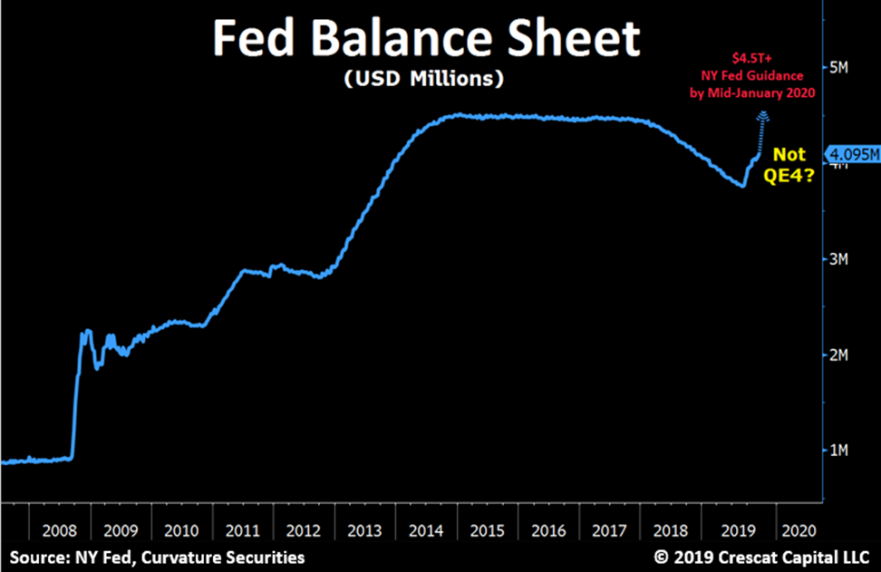
Repo CrisisThe Fed is in fight-or-flight mode because there are very real credit bottlenecks in the plumbing of the banking system that have created a US Treasury funding emergency. The central bank has been forced to add $364 billion of Treasury securities to its balance sheet over last four months and has committed to another $471 billion though mid-January. The money printing was necessary to fight a repo market funding shortage that warns of a systemic financial crisis in the making. Usually when the repo alarm bell flashes, it’s too late. Because of the Fed’s swift action, mayhem was averted but likely only in the very short-term. Major imbalances remain. One huge problem is that investors at large do not even know what a repo crisis means, so they have been interpreting the cash injections as a reason to go all in on risky assets. The bullish investor sentiment and positioning among investors last week reached the highest levels we have ever seen. Such ebullience in the past has been associated with major stock market tops. Today, we have structural imbalances and catalysts to make that a highly likely scenario, potentially even as we head into year end.
The Fed miscalculated the level of reserves it should have kept in the system so that banks can smoothly supply credit to the securities and FX markets and fulfill their regulatory capital requirements at the same time. So, it was a complete surprise on September 17, when US Treasury repo funding market froze up and the overnight rate jumped as high as 10% that day. Since then, the Fed has been trying to prevent a disorderly deleveraging of the entire financial system. Short-term interbank lending is the core of the entire financial system. When repo rates spike, it means there is not even enough cash in the system for banks to support the Treasury market, let alone the rest of the securities and FX markets to allow their normal functioning. For instance, when the repo rate jumped in September 2008, it froze the global financial system and bankrupted Lehman Brothers, so it’s a big problem.
The repo rate is also the short-term financing cost for financial institutions such as hedge funds to buy Treasury securities on margin including buying long duration Treasuries to speculate on a declining interest rates and/or deflation. It is one side of the popular risk parity trade among large hedge funds and institutional investors. In 2019, investors crowded into long duration Treasuries as the yield curve inverted in anticipation of a recession. The 10-year yield had its biggest year-over-year decline ever. After such a move, this trade simply became too crowded. In our view, it has already played out. Today, we believe there is a strong case for rising global yields on the long end of the curve as we explain below.
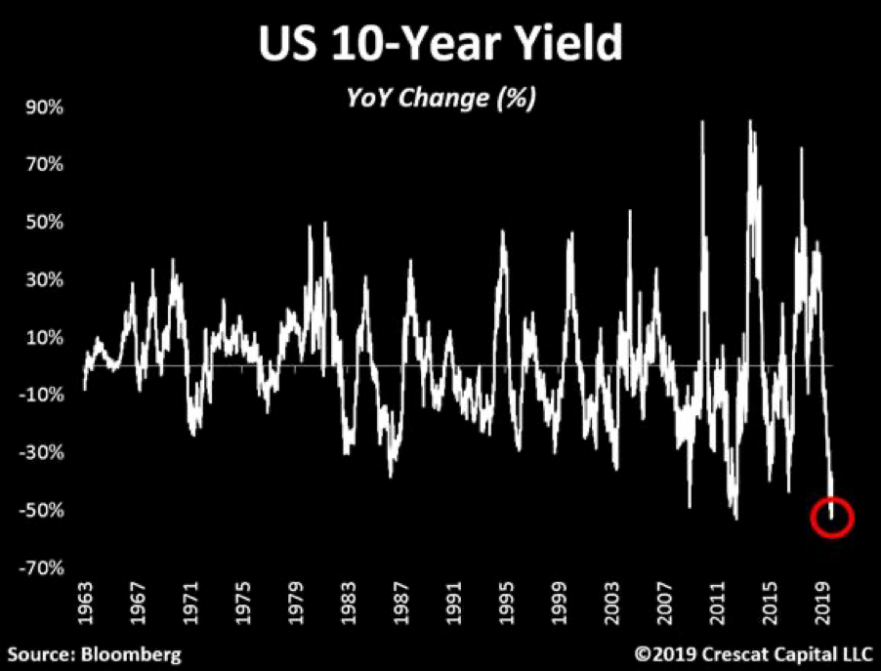
One thing the average investor is likely not paying attention to is the selloff on the long end of the Treasury curve which indicates that the repo funding problem may not been contained yet. Rising long-dated yields preceded the September shock and have only continued during the emergency Fed injections. Large hedge funds and institutions have crowded into leveraged long bond positions which rely on repo funding. If credit tightness continues these positions could be forced unwind creating more market instability necessitating the official beginning of the QE4. It’s key to note that it’s not just US Treasuries but the entire global sovereign long end that has been selling off.
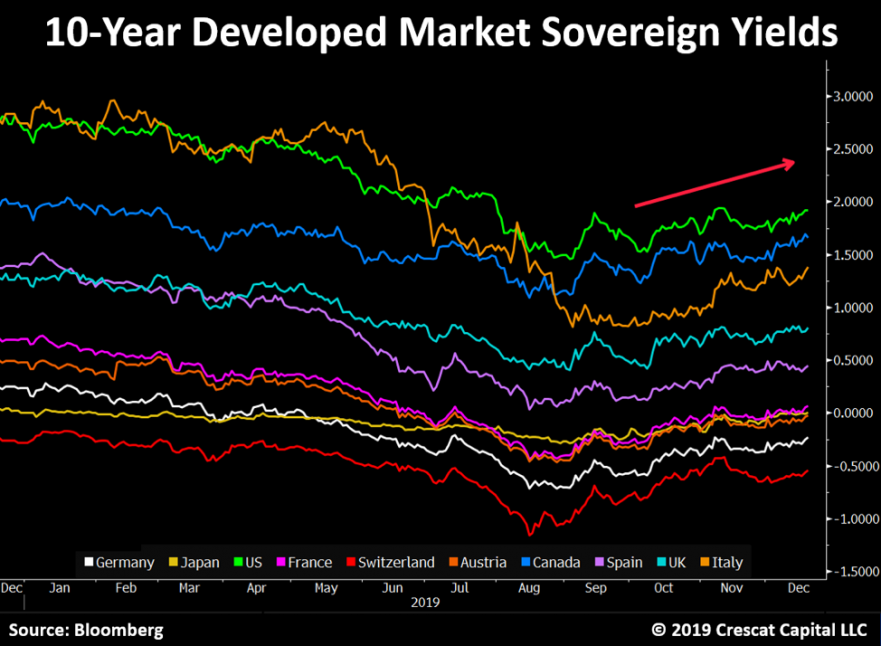
Running HotThe Fed’s monetary policy is running hot and long-term interest rates aren’t aligned accordingly. John Taylor, a Stanford University economist once considered to lead the Federal Reserve, developed a formula to calculate where the Fed funds rate should hypothetically be according to inflation rates, strength of the labor market, and potential output of the economy. Using that as our baseline for interest rates, the Fed isn’t just running an aggressive inflationary policy on the short end of the curve, long-term rates are also notably out of balance. For instance, the 10-yr yield vs. the Baseline Taylor Rule rate is now at its most extreme in 44 years. Inflation became a problem during all times this spread went negative. What makes this issue even more unique is the fact that on top of running an extreme loose rate policy, the Fed is printing money in a massive way. It’s hard to say monetary policy won’t come at a major cost this time.
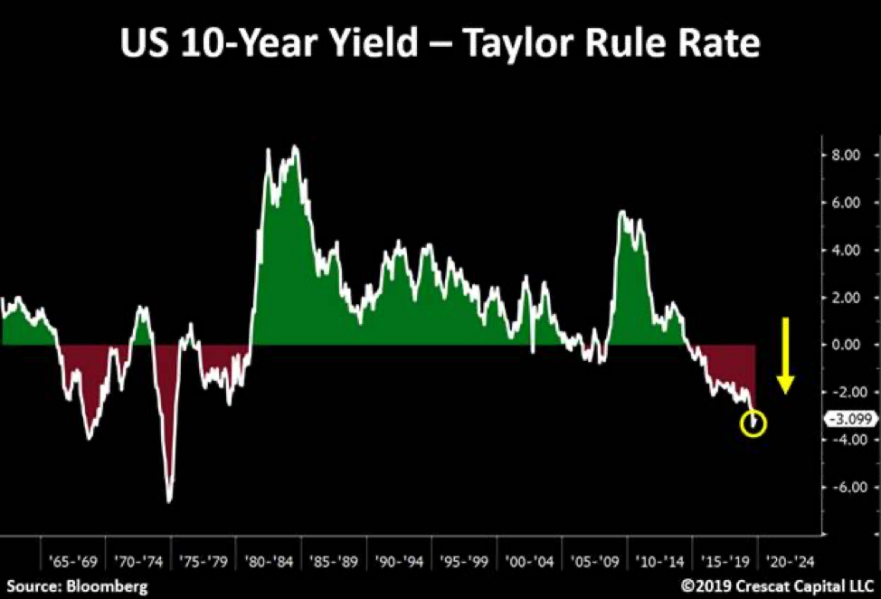
This is not only a domestic phenomenon. We see this issue worldwide. Germany’s case, for instance, is twice as extreme. According to the Taylor rule formula, short term interest rate should be close to 8%. In contrast, ECB rates are close to -0.5% while bunds’ 10-year yields are at -0.22%. The spread of between German long-term rates and its baseline Taylor rule rate is now at its highest level in history.

Below are similar disparities across the globe to consider. Most of them are in Europe, but almost the entire world should start seeing more pressure on long-term interest rates to rise while global central banks continue to run aggressive monetary policies to foster a global economic expansion now nearing exhaustion while funding record indebted governments.
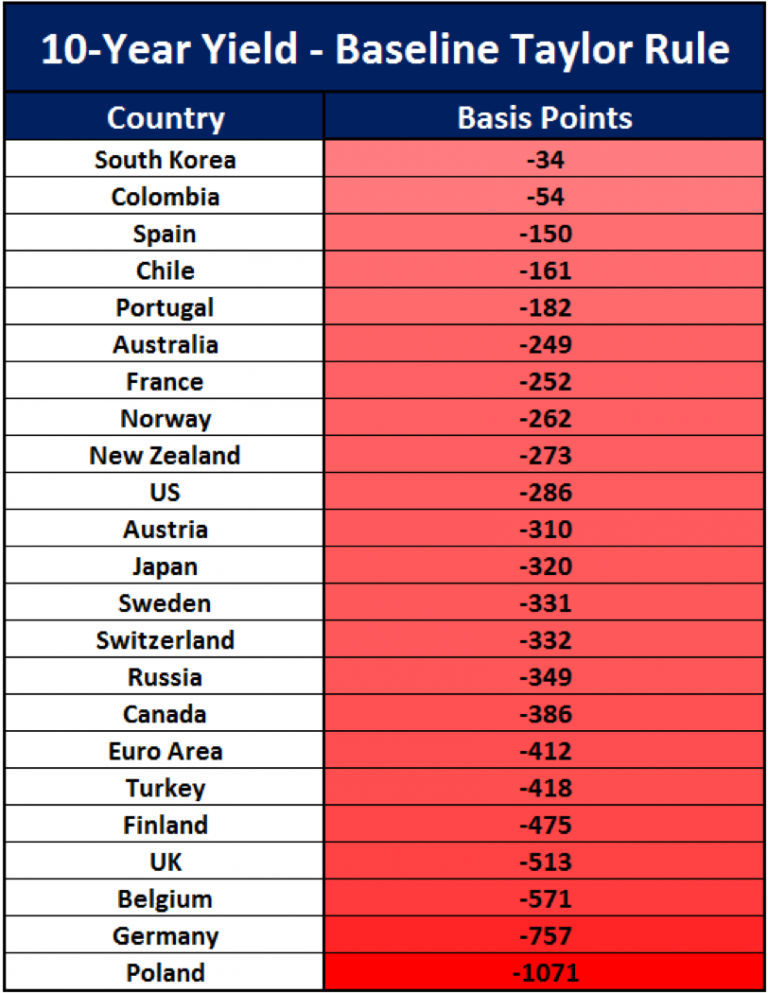
The Labor Market and Consumer Confidence – Falling into PlaceStocks are on pace for their best performance in 22 years all the while many key fundamentals such as corporate earnings and industrial production have been deteriorating all year. Continued gains for the broad stock market in 2020 are highly improbable in our view as even more of the key fundamentals in the jobs and consumer market are only just starting to roll over from exuberant extremes.
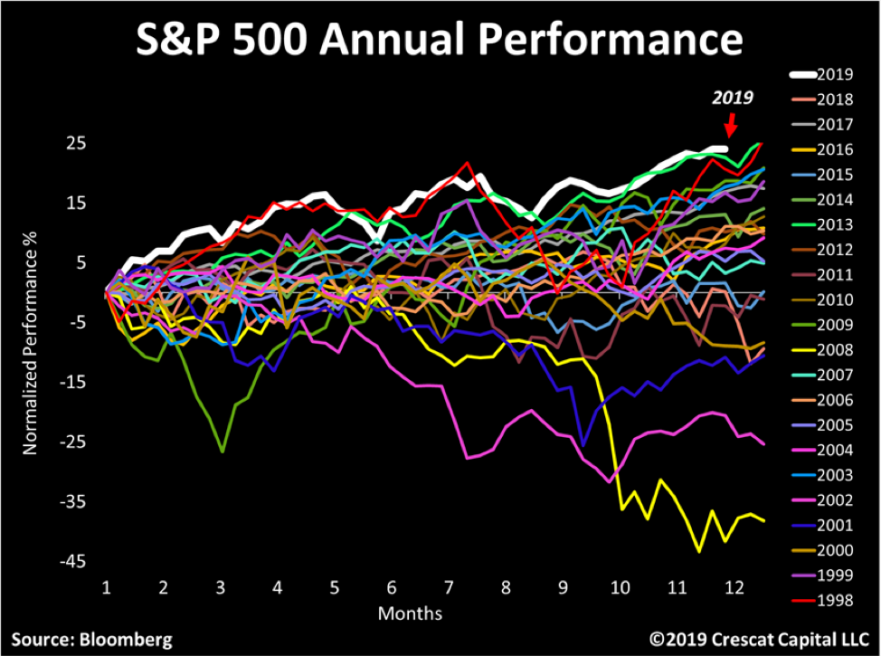
Among the many imbalances and catalysts we cited in last month’s recent research letter, the over-extended labor market is showing significant signs of cooling. The lagging and contrarian unemployment rate from the Bureau of Labor Statistics remains near cycle lows, just like it always does at the peak of a business cycle, right before a market downturn and recession. Meanwhile, three leading employment indicators are showing signs of significant cracks:
- (1) Declining BLS Job Openings;
- (2) Spiking DOL Initial Jobless Claims; and
- (3) A recent plunge in the ADP Employment Report
The ADP report calls into question the more optimistic BLS job numbers with the largest negative divergence since 2010. The year-over-year change for ADP payrolls is decelerating in a pattern last seen directly ahead of the Global Financial Crisis. What’s crucial is that the 3-month rolling average of ADP payrolls leads the rate of change in unemployment rate by 3 months with a correlation of almost 0.9!
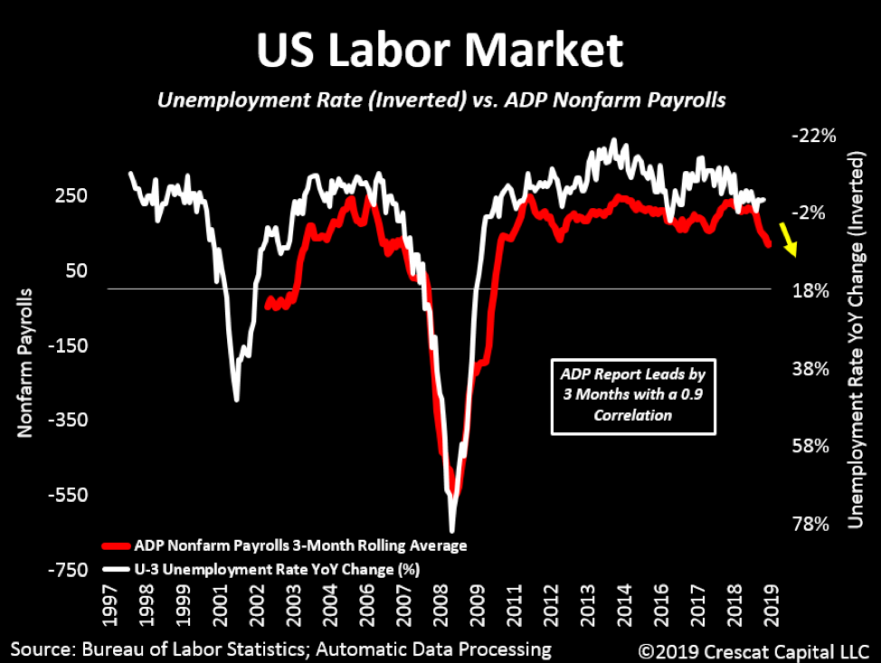
We have likely reached peak consumer complacency, another key piece of the macro puzzle. After retesting tech bubble levels, the Bloomberg Personal Finance Survey index is now falling and significantly diverging from the Conference Board’s Consumer Confidence. With the jobs market topping out, we believe consumer confidence will be the next shoe to drop.

Cost of Capital Poised to RiseThe bull case for stocks rests on one major liquidity force, the cost of capital. That’s driven by the availability of credit and the strength of company fundamentals. When looking at equities broadly, aggregate earnings per share for Russell 3000 index just started to fall on a year over year basis. Furthermore, corporate balance sheets never looked so weak. Leverage ratios are at record highs, and in contrast, companies with a junk credit status are now borrowing money at their lowest levels since the peak of the housing bubble. For instance, the Bloomberg Barclay High Yield (Ex-Energy) Index today is at its lowest premium to 10-year Treasuries since June of 2007.
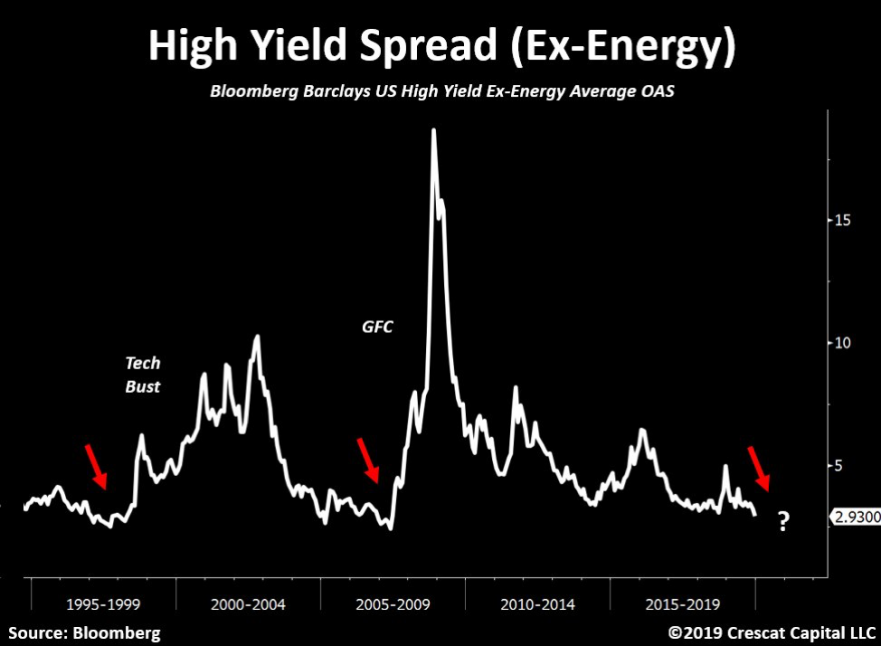
When default risk returns and interest rates spike higher, many of these low-credit-quality businesses will not survive. Since WeWork had to scrap its plans to go public and other recent new issues broke below their IPO price, investors have been turning their focus away from top-line growth towards companies that have underlying free cash flow profitability, or at least a clear path to get there soon. We believe this shift in mindset is already forcing companies to either raise prices of goods and services or cut costs to improve margins, and we expect this trend to continue. These changes should have a significant impact on consumer prices, labor markets, and the business cycle.
In this backdrop, we question if the demand for low-rated bonds will remain strong relative to higher quality assets. Junk bonds only yield 180 basis points higher than median CPI! It’s the lowest level in the history of the data.

To add to the bearish thesis, the 3-month implied volatility for put options on JNK, a high yield corporate bond ETF, is now at its lowest level ever. Prior cyclical lows in volatility preceded significant selloffs in this ETF as well as overall stocks. We view this as an opportunistic entry point to short junk bonds ahead of a business cycle downturn that is fast approaching.
Precious MetalsPrecious metals are poised to benefit from what we consider to be the best macro set up we’ve seen in our careers. The stars are all aligning. We believe strongly that this time monetary policy will come at a cost. Look in the chart below at how the new wave of global money printing just initiated by the Fed in response to the Treasury market funding crisis is highly likely to pull depressed gold prices up with it.
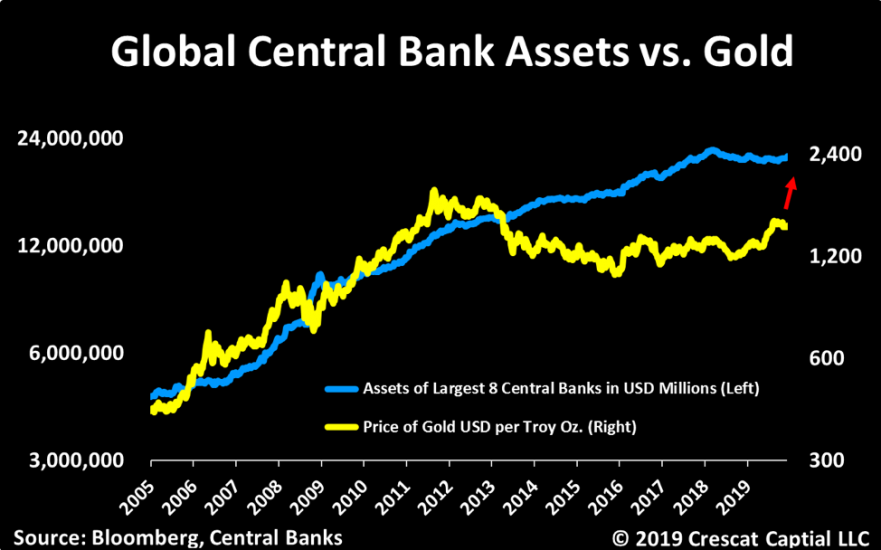
The imbalance between historically depressed commodity prices relative to record overvalued US stocks remains at the core of our macro views. On the long side, we believe strongly commodities offer tremendous upside potential on many fronts. Precious metals remain our favorite. We view gold the ultimate haven asset to likely outperform in an environment of either a downturn in the business cycle, rising global currency wars, implosion of fiat currencies backed by record indebted government, or even a full-blown inflationary set up. These scenarios are all possible. Our base case is that governments and central banks will keep their pedals to the metal to attempt to fend off credit implosion or to mop up after one has already occurred until inflation becomes a persistent problem.
The gold and silver mining industry is precisely where we see one of the greatest ways to express this investment thesis. These stocks have been in a severe bear market from 2011 to 2015 and have been formed a strong base over the last four years. They are offer and incredibly attractive deep-value opportunity and appear to be just starting to break out this year. We have done a deep dive in this sector and met with over 40 different management teams this year. Combining that work with our proprietary equity models, we are finding some of the greatest free-cash-flow growth and value opportunities in the market today unrivaled by any other industry. We have also found undervalued high-quality exploration assets that will make excellent buyout candidates.
We recently point out this 12-year breakout in mining stocks relative to gold now looks as solid as a rock. In our view, this is just the beginning of a major bull market for this entire industry. We encourage investors to consider our new Crescat Precious Metals SMA strategy which is performing extremely well this year.

Zero Discounting for Inflation Risk TodayWith historic Federal debt relative to GDP and large deficits into the future as far as the eye can see, if the global financial markets cannot absorb the increase in Treasury debt, the Fed will be forced to monetize it even more. The problem is that the Fed’s panic money printing at this point in the economic cycle may hasten the unwinding of the imbalances it is so desperate to maintain because it has perversely fed the last-gasp melt up of speculation in already record over-valued and extended equity and corporate credit markets. It is reminiscent of when the Fed injected emergency cash into the repo market at the peak of the tech bubble at the end of 1999 to fend off a potential Y2K computer glitch that led to that market and business cycle top.
After 40 years of declining inflation expectations in the US, there is a major disconnect today between portfolio positioning, valuation, and economic reality. Too much of the investment world is long the “risk parity” trade to one degree or another, long stocks paired with leveraged long bonds, a strategy that has back-tested great over the last 40 years, but one that would be a disaster in a secular rising inflation environment.
With historic Federal debt relative to GDP and large deficits into the future as far as the eye can see, rising long-term inflation, and the hidden tax thereon, is the default, bi-partisan plan for the US government’s future funding regardless of who is in the White House and Congress after the 2020 elections. The market could start discounting this sooner rather than later.
The Fed’s excessive money printing may only reinforce the unraveling of financial asset imbalances today as it leads to rising inflation expectations and thereby a sell-off in today’s highly over-valued long duration assets including Treasury bonds and US equities, particularly insanely overvalued growth stocks. We believe we are in the vicinity of a major US stock market and business cycle peak.
* * *
Download PDF Version here |




